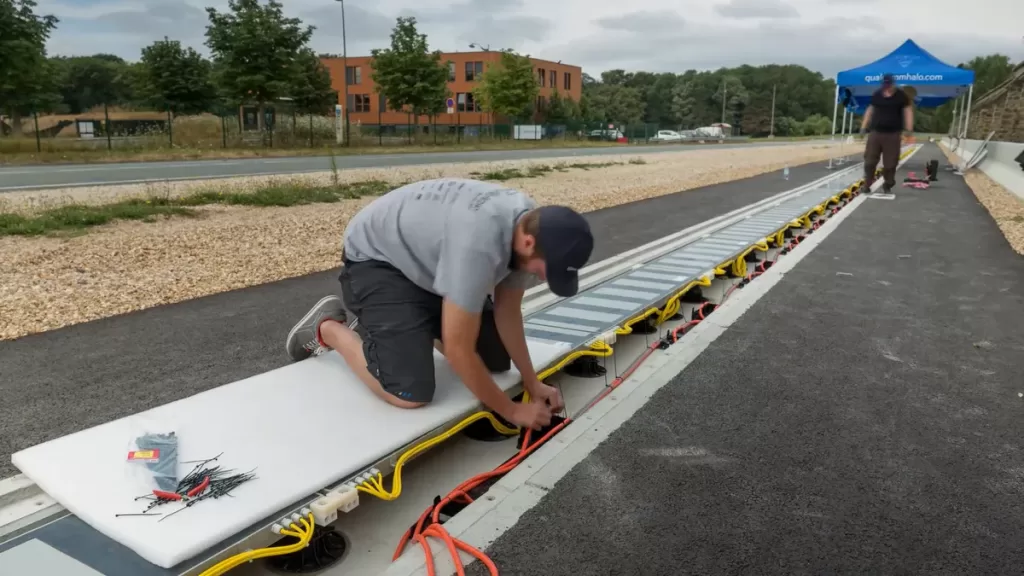Charging on the Move
This might sound like science fiction, but it isn’t.
There are constant conversations surrounding electric vehicles. But what if we could drive down a highway while our car silently recharges… What if there were no need for pit stops and cables, but just seamless motion? France has just made that vision a reality with the world’s first EV charging road. This pilot project, on a 1.5-kilometre stretch of the A10 motorway near Paris, is part of a broader effort to make highways smarter and greener (VINCI Autoroutes, 2025).
How does this work? Engineers have embedded copper coils beneath the asphalt layer (transmitter), allowing electricity to be transferred to moving vehicles (receiver) through magnetic induction (VINCI Autoroutes, 2025). The working mechanism is similar to the battery-loaded wireless charging devices we use every day. So, compatible electric vehicles (EVs) equipped with special receivers can now charge wirelessly while driving, thus marking the world’s first real-traffic trial of its kind. Unlike traditional EV chargers, where the vehicle has to stop, plug in, and wait, this system lets vehicles top up continuously, like a phone on a wireless pad, but at highway speeds (Electreon, 2024).

Source: CNET Roadshow, 2025
The system, developed by VINCI Autoroutes in partnership with Electreon Wireless and Université Gustave Eiffel, can deliver up to 200 kW continuously, with peak power above 300 kW, which is enough to power heavy trucks or buses while cruising (Electreon, 2024). While Sweden began testing dynamic charging with its Smartroad Gotland project in 2019 and Italy’s Arena del Futuro is exploring similar technology, France’s pilot stands out as a longer, large-scale real-world demonstration on a public motorway (Smartroad Gotland, 2023; Stellantis, 2023).
Why It Matters
This concept of highways turning into dynamic power networks, tackles two major challenges for EV owners: range anxiety and charging downtime. In other words, instead of waiting at a plug‑in station for hours, drivers could top up while driving, turning highways into active charging corridors. And not to mention the anxiety of getting stuck during long drives with little or no access to immediate charging stations on highways. So, this is definitely a relief for EV drivers. It also allows for smaller, lighter battery production for future EV vehicles, reducing the need for bulky batteries. This directly means lower manufacturing emissions, lighter vehicles, and more affordable EVs while protecting ecosystems (NREL, 2025 ; VINCI Autoroutes, 2025).

Source: Movyon, 2023
France’s transport sector remains one of the largest sources of greenhouse gas emissions in the country, with 30% of emissions in 2021. The challenges are particularly high for road transport, which accounts for 94% of the sector’s emissions (UNFCCC, 2021). This underlines why initiatives like Electric Road Systems (ERS) are so vital for decarbonising mobility (F3 centre, 2020). And projects such as the A10 pilot, aligning with the EU’s strategy, should be supported for achieving carbon-neutral mobility by 2050.
DID YOU KNOW?
Lighter EV batteries do more than just improve efficiency? They can significantly reduce the environmental impact of battery production. For example, manufacturing a 28 kWh lithium-ion battery in China generates about 2.7–3.1 tonnes of CO2-equivalent, accounting for roughly 30% of a vehicle’s total manufacturing emissions (Hao, Mu, Jiang, Liu, & Zhao, 2017). Mining and processing raw materials like lithium, cobalt, and nickel contribute up to 40% of these emissions (Institute for Energy Research, 2023).
Road Ahead
Supported by Bpifrance, the nation’s public investment bank, this project is part of a growing network of Electric Road System (ERS) pilots across Europe. If successful, France aims to extend the technology to nearly 9,000 kilometres of highways by 2035 (VINCI Autoroutes, 2025). Meanwhile, the U.S. opened a short inductive charging stretch in Detroit in 2023, but France’s motorway-scale trial stands out for its larger scope and full operational deployment (State of Michigan, 2023).
However, there remain significant hurdles. Embedding inductive coils in highways comes with substantially higher costs. Movyon (2023) mentions that the infrastructure costs can be over €2 million per kilometre for inductive charging lanes, far above traditional plug-in charging infrastructure. Moreover, the industry has to develop and refine universal technical standards and protocols for dynamic wireless in-road charging compatible across vehicle makes and brands. This is a critical barrier to large-scale rollout (ICCT, 2022).
There’s still a long journey ahead with questions about installation costs, grid integration, and vehicle standardisation, but the direction toward a green future is clear. By transforming highways into living energy networks, France isn’t just building roads; it’s creating a blueprint for sustainable, connected, and carbon-free mobility. Imagine fleets of buses, delivery trucks, and everyday EVs moving endlessly without stopping to charge, cutting urban pollution, easing traffic, and making clean transportation accessible for everyone. It’s a vision of thriving urban environments working in harmony with nature, technological innovation, and renewable resources.























